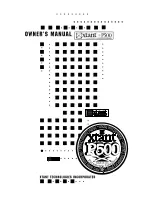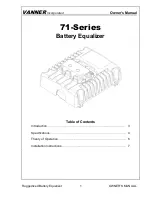
© 2003 TDM Audio, Inc.
Graphic Equalizer Owner’s Manual
Page 6
Equalizer Terminology
•
Filter:
An electronic circuit that changes the levels of some frequencies without altering
the levels of others.
•
Frequency Band:
The range of frequencies that a particular filter operates on. Graphic
equalizers have one slider for each frequency band that they can control.
•
Band Width:
Specifies how broad a range of frequencies is encompassed by a frequency
band. Audio band widths are often given in octaves. TDM 15GE-2 graphic equalizers
operate on fixed bands that are 1/3 of an octave wide. That is why they are called 1/3
octave equalizers.
•
Boost and Cut:
Boosting a range of frequencies raises their level relative to the overall
level of the signal. Cutting a range of frequencies lowers their level relative to the overall
signal level. The amount of boost or cut is given in Decibels (dB). TDM 15GE-2 graphic
equalizers can provide up to 12 dB of boost or cut for each frequency band.
•
Bypass:
Bypassing a piece of signal processing equipment means electronically
removing it from the signal path. When you press the bypass switch, the unit internally
disables all signal processing. Thus it has the effect of simply routing the input to the
output as though the equipment were not there.
•
Constant-Q:
A design requirement for some equalizers that says that the band width and
characteristic
shape
or
sound
of filters remains constant as the center frequency varies. In
graphic equalizer design this means that each of the filters has the same effect on its
range of frequencies as all of the other filters have on theirs. TDM 15GE-2 graphic
equalizers are constant-Q designs.
•
Interaction:
Because of the way most equalizers work, adjacent bands
interact.
In other
words, changing the level of one band affects the levels of frequencies in adjacent bands.
This interaction makes it more difficult to adjust equalizers accurately because you need
to keep going back and readjusting the levels of some bands after changing the adjacent
levels.
15GE-2 Special Features
•
Hard-Wire Bypass:
When you engage the bypass switch on the TDM 15GE-2 graphic
equalizers, the inputs are electrically “hard wired” directly to the outputs with no
intermediate circuitry. This means that in a bypassed state the unit is truly, completely
removed from the signal path. Many equalizers have a bypass switch that simply
deactivates equalization. The signal still goes through the equalizer’s electronics. The
hard-wire bypass is very useful when diagnosing system problems, and it works even
when no power is applied to the unit.
•
Non-Interactive Adjacent Bands:
Special circuitry in the TDM 15GE-2 graphic
equalizers reduces adjacent band interaction until it is virtually nonexistent. Each filter’s
characteristics are electrically dependent on the settings of adjacent bands so the filters
automatically compensate for interaction. This makes the TDM 15GE-2 equalizers easier
to adjust than most.


































